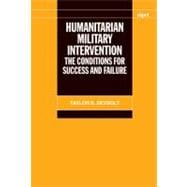
Note: Supplemental materials are not guaranteed with Rental or Used book purchases.
Purchase Benefits
What is included with this book?
| Preface to the paperback edition | p. vii |
| Preface to the hardback edition | p. viii |
| Acknowledgements | p. x |
| Abbreviations and acronyms | p. xi |
| Northern Iraq, 1992 | p. xiii |
| Somalia | p. xiv |
| Bosnia and Herzegovina, April 1995 | p. xv |
| Rwanda, August 1994 | p. xvi |
| Kosovo, 1999 | p. xvii |
| East Timor, 1999 | p. xviii |
| Controversies about humanitarian military intervention | p. 1 |
| Humanitarian intervention debates | p. 7 |
| The structure of this book | p. 28 |
| Judging success and failure | p. 30 |
| What is success? | p. 30 |
| Counting people who did not die | p. 32 |
| A typology of humanitarian military intervention | p. 38 |
| Summary | p. 45 |
| Military responses to humanitarian dilemmas | p. 40 |
| A typology of humanitarian military intervention | p. 42 |
| Humanitarian military interventions in the 1990s | p. 46 |
| State oppression of the Kurds in northern Iraq, 1991-96 | p. 47 |
| State failure and famine in Somalia, 1991-95 | p. 52 |
| Secession and ethnic expulsion in Bosnia and Herzegovina, 1992-95 | p. 61 |
| Genocide and civil war in Rwanda, 1994 | p. 70 |
| Secessionist violence and ethnic expulsion in Kosovo, 1999 | p. 78 |
| Independence and fear in East Timor, 1999-2000 | p. 86 |
| Summary | p. 93 |
| The impact of intervention in northern Iraq, 1991-96 | p. 48 |
| The impact of intervention in Somalia, 1991-95 | p. 60 |
| The impact of intervention in Bosnia and Herzegovina, 1992-95 | p. 68 |
| The impact of intervention in Rwanda, 1994 | p. 78 |
| The impact of intervention in Kosovo, 1999-2000 | p. 80 |
| The impact of intervention in East Timor, 1999-2000 | p. 90 |
| Helping to deliver emergency aid | p. 96 |
| Strategies for delivering aid | p. 97 |
| Direct aid and logistics provision in the 1990s | p. 106 |
| Advantages and disadvantages of military intervention to help provide aid | p. 131 |
| Summary | p. 133 |
| Variations of direct aid and logistical assistance | p. 106 |
| Protecting humanitarian aid operations | p. 135 |
| Strategies for protecting aid operations | p. 136 |
| Protecting aid operations in the 1990s | p. 145 |
| Advantages and disadvantages of military intervention to protect aid operations | p. 172 |
| Summary | p. 176 |
| Various forms of military protection of aid operations | p. 140 |
| Saving the victims of violence | p. 177 |
| Strategies for protecting civilians | p. 180 |
| Saving the victims of violence in the 1990s | p. 191 |
| Advantages and disadvantages of military intervention to save the victims of violence | p. 218 |
| Summary | p. 220 |
| Various forms of saving civilian victims | p. 184 |
| Defeating the perpetrators of violence | p. 222 |
| Strategies for defeating the perpetrators of violence | p. 224 |
| Defeating the perpetrators of violence in the 1990s | p. 230 |
| Advantages and disadvantages of military intervention to defeat the perpetrators of violence | p. 262 |
| Summary | p. 265 |
| Various outcomes of offensive action to defeat perpetrators of violence | p. 226 |
| The prospects for success and the limits of humanitarian intervention | p. 267 |
| Taking stock | p. 270 |
| Choosing among types and strategies | p. 274 |
| The limits of humanitarian military intervention | p. 276 |
| Concluding comments | p. 280 |
| Success and failure in humanitarian military intervention in the 1990s | p. 272 |
| Index | p. 282 |
| Table of Contents provided by Ingram. All Rights Reserved. |
The New copy of this book will include any supplemental materials advertised. Please check the title of the book to determine if it should include any access cards, study guides, lab manuals, CDs, etc.
The Used, Rental and eBook copies of this book are not guaranteed to include any supplemental materials. Typically, only the book itself is included. This is true even if the title states it includes any access cards, study guides, lab manuals, CDs, etc.